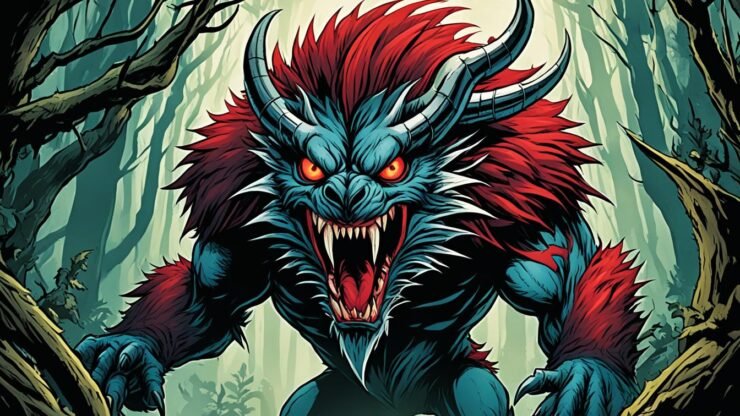Deep within the rich tapestry of Philippine folklore, a malevolent creature known as the Sigbin has captured the imagination of Filipinos for generations.1 This enigmatic being, with its unsettling physical traits and mysterious origins, stands out as a particularly sinister and captivating figure in the country’s vast pantheon of mythological entities.1
One evening, as the moon rose high above the sleepy village, a faint rustling in the shadows caught the attention of a young boy, Alwi. Drawn by a strange fascination, he peered into the darkness, where he glimpsed a peculiar creature with oversized ears and a long, whip-like tail. As the creature turned towards him, Alwi recoiled in horror, for the Sigbin’s nauseating stench had already begun to overwhelm his senses.1 Terrified, he fled, his heart racing, for the tales of the Sigbin’s heart-stealing powers had long been whispered among the elders of the community.
The story of Alwi’s encounter with the Sigbin sets the stage for a deeper exploration of this malevolent creature and its enduring presence in the rich tapestry of Philippine mythology.1 As one of the many diverse mythological beings that populate the archipelago, the Sigbin stands out as a particularly unsettling and captivating figure, its unique characteristics and sinister legends cementing its place in the cultural imagination of the Filipino people.
Key Takeaways
- The Sigbin is a malevolent creature from the rich tapestry of Philippine mythology, known for its foul stench and ability to steal the hearts of its victims.
- The Sigbin has captured the imagination of Filipinos for generations, with its distinctive physical traits and mysterious origins.
- The Sigbin is one of the many diverse mythological entities that populate the Philippines, reflecting the country’s vast and complex folkloric traditions.
- Legends and beliefs surrounding the Sigbin are deeply rooted in the cultural and spiritual beliefs of the Filipino people.
- The Sigbin’s enduring presence in Philippine mythology highlights the continued relevance and fascination with these supernatural creatures.
Introduction to Philippine Mythological Creatures
The Philippines is home to a vast and diverse array of mythological creatures, each with their own unique histories, characteristics, and cultural significance.1 These beings are deeply rooted in the various ethnic groups and indigenous belief systems that have flourished across the archipelago for centuries. The origins of these creatures can be traced to a rich tapestry of animistic religions, ancestor worship, and nature reverence that pre-date the arrival of Christianity and other foreign influences. Understanding the significance of these mythological creatures is crucial in contextualizing the cultural identity and worldview of the Filipino people.
Origins and Significance of Filipino Folklore
The mythological creatures of the Philippines vary widely across the different ethnolinguistic groups and regional traditions.1 From the towering Kapre of Luzon to the shape-shifting Aswang of the Visayas, each ethnic community has its own unique pantheon of supernatural beings. This diversity reflects the complex and multilayered nature of Filipino folklore, which has been shaped by the country’s long history of cultural exchange, migration, and adaptation. Exploring the distinct characteristics and beliefs surrounding these creatures provides valuable insights into the unique worldviews and lived experiences of the Filipino people.
Diversity of Creatures Across Various Ethnic Groups
1 The list of mythological creatures in Philippine mythology covers figures such as Aswang, Diwata, Duende, Mambabarang, Manananggal, Mangkukulam, and more. Some generic bracket terms are used to encompass groups of mythological creatures such as Aswang for shape-shifting creatures and Duwende for small magical beings. Specific creatures like Kapre, Sirena, Bakunawa, and Sigbin have unique characteristics and stories associated with them. The diverse range of characters also includes malevolent beings like Inlabbuut, gentle creatures like Panigotlo, and mischievous entities like Pilandok.
1 Various creatures such as Dwende, Engkanto, and Kalapao are part of the diverse mythical beings found in Philippine mythology. Nuno sa punso, Tikbalang, and Engkantada are examples of creatures with specific roles or habitats within Philippine folklore. Folk beliefs and mythologies also include tales of giants like Bungisngis, giant serpents like Sawa, and creatures of the sea like Dogong. Witches like Mambabarang and Mangkukulam are part of the mystical landscape in Philippine mythology.
1 Some creatures like Amalanhig, Amomongo, and Santelmo are described as undead monsters, man-sized apes, and mystical phenomena respectively. The diverse range of characters also includes malevolent beings like Inlabbuut, gentle creatures like Panigotlo, and mischievous entities like Pilandok.
The Enigmatic Sigbin
Physical Description and Identifying Traits
The Sigbin is a peculiar and unsettling creature in Philippine mythology, known for its distinctive physical features and unsettling behaviors. Described as a goat-like being with oversized ears, a long whip-like tail, and two grasshopper-like legs on its neck, the Sigbin is said to possess the ability to crab-walk backwards and emit a foul, nauseating stench.2 These unique traits make the Sigbin easily identifiable, contributing to its fearsome reputation among the Filipino people.
Legends and Beliefs Surrounding the Sigbin
The Sigbin is the subject of numerous legends and beliefs within Philippine folklore, which often depict the creature as a malevolent, heart-stealing entity. According to these myths, the Sigbin is said to roam the night in search of unsuspecting children, whom it will devour, keeping their hearts to create powerful amulets.2 The creature’s foul odor is believed to be a key characteristic, as it is said to use this noxious stench to disorient and incapacitate its victims.2 These beliefs and legends surrounding the Sigbin have contributed to its enduring place in the Filipino consciousness as a figure of fear and superstition.
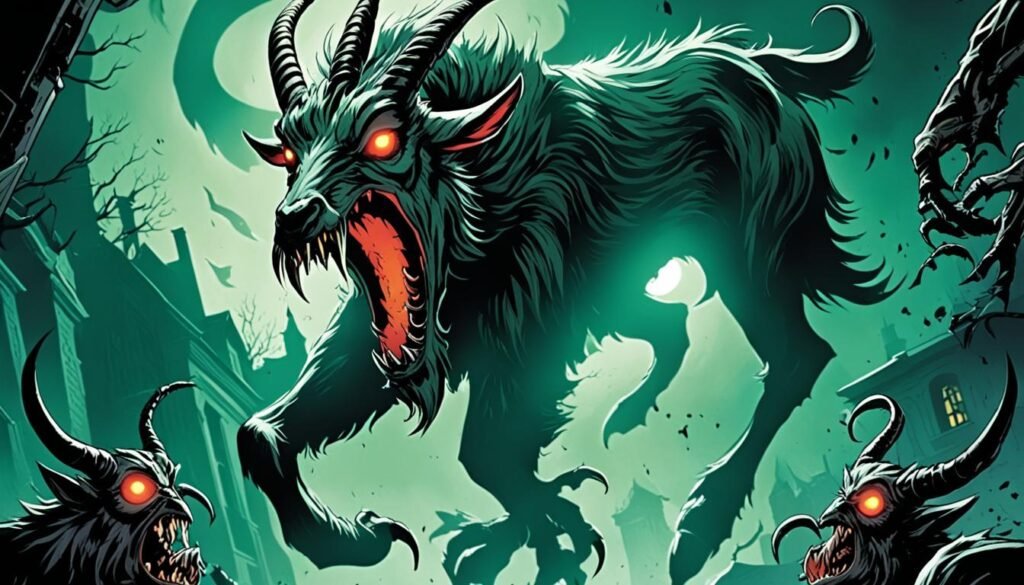
Creatures of the Soil in Philippine Mythology
The Philippines is home to a rich tapestry of mythological creatures that are believed to inhabit the earth and its various natural features.1 From the diminutive Nuno sa Punso, or “Goblin of the Mound,” who resides in ant hills, to the towering, tree-dwelling Kapre, these beings are deeply rooted in the animistic beliefs and reverence for nature that are prevalent in Filipino folklore.1 Other creatures of the soil include the Pugot, a shapeshifting fiend that haunts abandoned dwellings, and the Intumbangel, a pair of intertwined snakes said to cause earthquakes.1 The close connection between these mythological entities and the natural world highlights the deep-seated belief among Filipinos in the inherent spirituality of the earth and its various elements.
These Philippine mythological creatures, such as the Nuno sa Punso and Kapre, are believed to inhabit the soil and natural features, reflecting the animistic beliefs and reverence for nature among Filipinos.1 The diversity of these beings, from diminutive goblins to towering tree-dwelling entities, underscores the rich tapestry of Filipino folklore and the deep connection between the spiritual and physical realms.1
| Mythological Creature | Description | Habitat |
|---|---|---|
| Nuno sa Punso | Diminutive “Goblin of the Mound” | Ant hills |
| Kapre | Towering, tree-dwelling entity | Forests and trees |
| Pugot | Shapeshifting fiend | Abandoned dwellings |
| Intumbangel | Pair of intertwined snakes | Cause earthquakes |
Malevolent Beings and Aswangs
The Philippines is also home to a host of malevolent beings and shapeshifting monsters, collectively known as Aswangs. These creatures encompass a variety of entities, including the Manananggal, a beautiful woman who can detach her upper torso and fly at night to prey on pregnant women3, and the Tiyanak, a vampiric infant that lures unsuspecting victims before attacking. The Aswangs are often depicted as viscera suckers, capable of consuming the internal organs of their victims, and possess the ability to shapeshift into various forms, adding to their sinister and unpredictable nature3.
Werebeasts and Witches
Alongside the Aswangs, the Philippines is also home to a variety of werebeasts and malevolent witches, known as Mangkukulam, who are believed to cast dark spells and curses. These beings, such as the Werewolf-like Tikbalang and the Mambabarang, who utilize insects to do their bidding, are seen as a constant threat to the well-being of the Filipino people3. The fear and superstition surrounding these creatures have been deeply ingrained in the cultural psyche, leading to the development of protective rituals and talismans to ward off their malevolent influence.
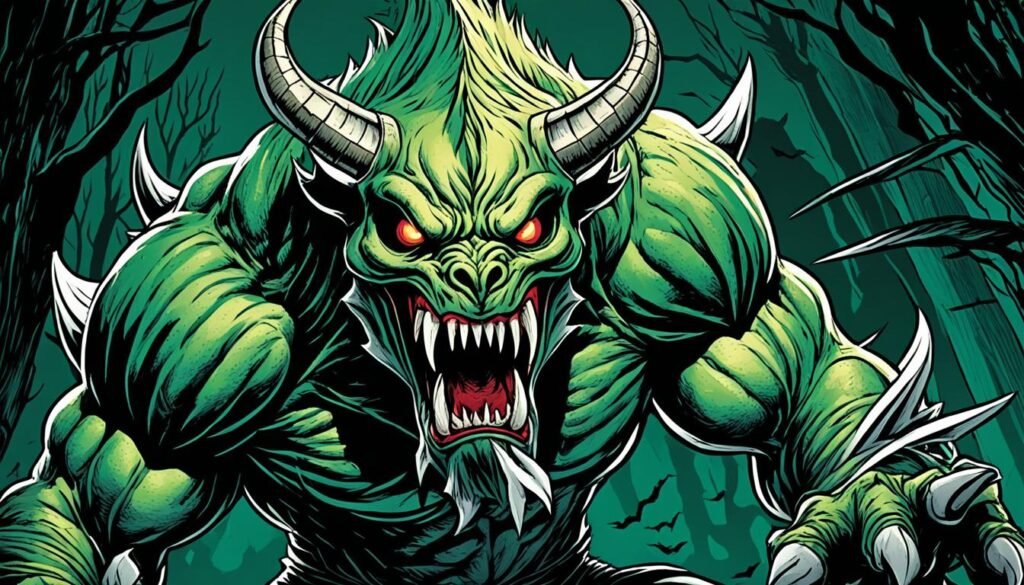
Sigbin: The Foul-Scented, Heart-Stealing Beast
Distinctive Features and Behavior
The Sigbin is a truly unique and unsettling creature within the pantheon of Philippine mythological beings. Its distinctive features, including the oversized ears, long whip-like tail, and grasshopper-like legs, make it easily identifiable.1 The Sigbin is also known for its ability to crab-walk backwards and emit a nauseating stench, which it uses to disorient and incapacitate its victims.1 These unsettling traits contribute to the Sigbin’s fearsome reputation and the widespread superstitions surrounding its appearance.
Mythical Origins and Cultural Significance
The origins and cultural significance of the Sigbin within Philippine mythology are shrouded in mystery and speculation. Some believe the creature may have roots in ancient animistic beliefs or folktales warning against the dangers of unchecked greed and malevolence.1 Others suggest the Sigbin may be a symbolic representation of the darker, more primal aspects of human nature.1 Regardless of its precise origins, the Sigbin has become an enduring figure in Filipino folklore, a reminder of the complex and often unsettling supernatural forces believed to exist within the archipelago.
Protective Rituals and Offerings
In response to the perceived threat posed by the Sigbin and other malevolent creatures in Philippine mythology, various traditional practices and rituals have developed to appease and ward off these supernatural entities.4 These may include the burning of specific herbs or incense, the placement of protective amulets or talismans, and the observance of certain taboos or customs. The Sigbin, in particular, is said to be deterred by the scent of burning rubber or the presence of salt, ash, and raw rice.4 These practices reflect the deep-seated belief among Filipinos in the power of ritual and spiritual intervention to safeguard against the dangers posed by the Sigbin and other supernatural forces.
Amulets and Talismans against Evil Creatures
In addition to protective rituals, the Filipino people have also developed a rich tradition of amulets and talismans to guard against the Sigbin and other malevolent creatures.4 These objects, often crafted from materials like bone, wood, or metal, are believed to possess inherent magical properties that can repel or neutralize the influence of these supernatural beings. The creation and use of these amulets and talismans is often steeped in specific cultural and spiritual practices, reflecting the deep-rooted belief in the power of these objects to safeguard against the dangers of the unseen world.
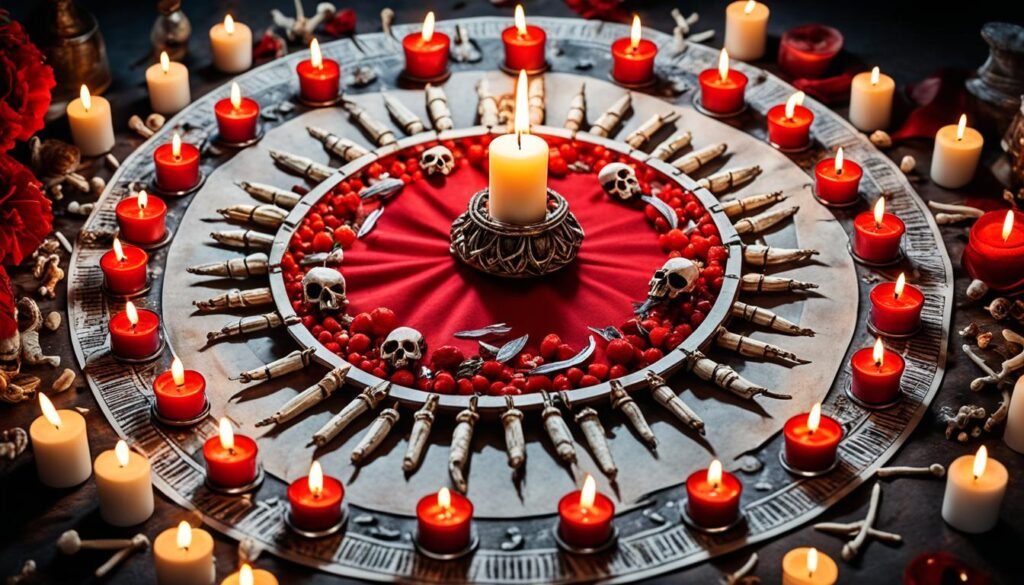
Regional Variations and Adaptations
As with many aspects of Filipino folklore, the legends and beliefs surrounding the Sigbin are not uniform across the archipelago. Instead, regional variations and adaptations of the creature have emerged, reflecting the diverse cultural and linguistic traditions of the different ethnic groups. In some areas, the Sigbin may be known by alternative names or associated with slightly different characteristics or behaviors.5 These regional differences underscore the dynamic and ever-evolving nature of Philippine mythological traditions, which continue to be shaped by the unique experiences and worldviews of the country’s various communities.
Sigbin in Modern Philippine Culture
The enduring fascination with the Sigbin and other Philippine mythological creatures has led to their widespread representation in literature, film, and other forms of media. From novels and graphic novels that delve into the dark and unsettling world of these supernatural beings to horror films that bring their sinister presence to life, the Sigbin has become a prominent figure in contemporary Filipino popular culture.6 These modern interpretations and adaptations not only showcase the continued relevance of the Sigbin in the Filipino consciousness but also contribute to the ongoing evolution and dissemination of these mythological narratives.
Despite the passage of time and the influence of modernization, the Sigbin and other Philippine mythological creatures continue to hold a prominent place in the cultural imagination of the Filipino people.6 These beings, with their distinctive features and unsettling behaviors, serve as a tangible link to the country’s rich and diverse folkloric heritage, reminding Filipinos of the enduring power of storytelling and the deep-rooted belief in the existence of supernatural forces.6 As such, the Sigbin and its ilk remain integral to the cultural identity and worldview of the Filipino people, ensuring their continued relevance and prominence in the years to come.
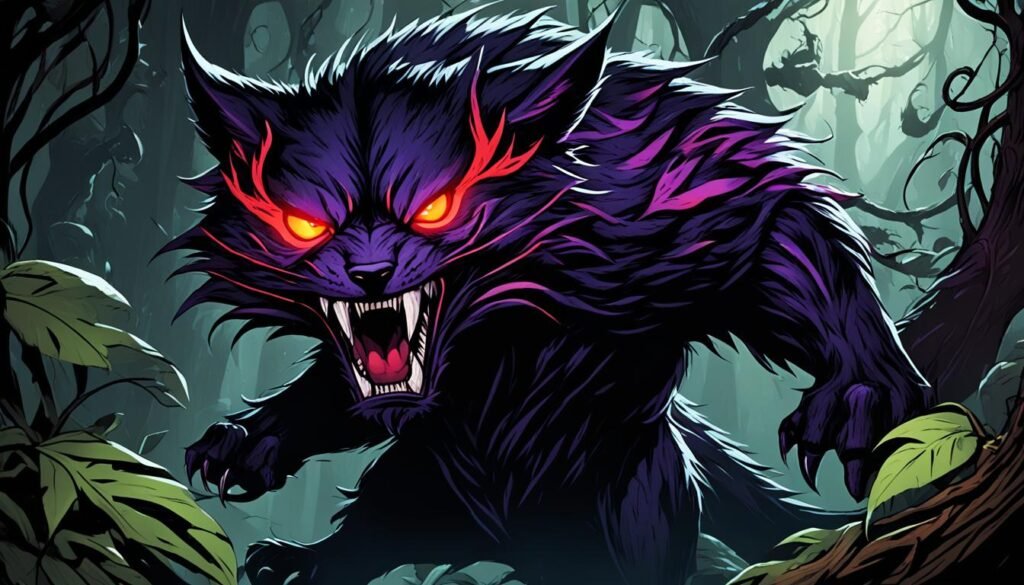
Mythical Heroes and Epic Tales
Alongside the malevolent and unsettling creatures that populate Philippine mythology, the country’s folkloric traditions also feature a rich tapestry of mythical heroes and epic tales.1 These narratives often center around the exploits of legendary figures who possess supernatural abilities or who engage in epic battles against powerful supernatural forces. The tales of these mythical heroes not only entertain and captivate, but also serve to impart important cultural values, moral lessons, and insights into the worldviews of the Filipino people. Exploring these heroic narratives provides a more holistic understanding of the multifaceted nature of Philippine mythology and its enduring influence on the national consciousness.
One such legendary figure is Bernardo Carpio, a mythological hero who is believed to have possessed extraordinary strength and the ability to move mountains. According to the tales, Bernardo Carpio engaged in an epic battle with a powerful supernatural entity, ultimately defeating the creature and protecting his people. These stories of heroic deeds and the triumph of good over evil have become deeply ingrained in the Filipino psyche, serving as a source of inspiration and cultural identity.
Similarly, the figure of Juan Tamad, a mythical character known for his laziness and indifference, has also become a prominent figure in Philippine folklore. While the character may initially appear to be a cautionary tale about the dangers of idleness, the stories surrounding Juan Tamad often convey deeper messages about the importance of balance, personal growth, and the recognition of one’s own potential.
These mythical heroes and epic tales not only entertain and captivate, but also serve as a powerful medium for the transmission of cultural values, beliefs, and worldviews. By exploring these narratives, we gain a deeper understanding of the rich and multifaceted nature of Philippine mythology, and its enduring influence on the national consciousness of the Filipino people.
Nature Spirits and Benevolent Entities
While the Philippines is renowned for its diverse array of malevolent and unsettling mythological creatures, the country’s folkloric traditions also feature a rich tapestry of benevolent nature spirits and guardians. Entities such as the Diwata, revered as the protectors of forests, mountains, and other natural resources, and the Nuno sa Punso, the diminutive “Goblins of the Mound,” are believed to play a vital role in maintaining the delicate balance of the natural world.4 These benevolent beings are often the subjects of rituals and offerings, reflecting the deep-seated reverence for the natural environment that is integral to many Filipino belief systems.4 Exploring these positive supernatural forces provides a more nuanced understanding of the complexities and diversity of Philippine mythology.
The term “Anito” refers to ancestor spirits, nature spirits, and deities in Indigenous Philippine folk religions.4 These spirits, known as “ninunò,” are believed to be guardian spirits, cultural heroes, or actual ancestors, guiding the souls of the departed to the spirit world.4 Pre-colonial Filipinos were animistic, believing that everything, from natural phenomena to abstract concepts, possesses a spirit.4 This belief system, where the material and spiritual realms coexist, is central to the understanding of these benevolent nature spirits and their role in the Filipino worldview.
The “Pag-anito” refers to a séance where a shaman acts as a medium to communicate with spirits.4 Through these rituals, Filipinos seek to appease and honor the benevolent entities that are believed to inhabit the natural world, from the Diwata spirits that personify natural phenomena to the diminutive Nuno sa Punso that dwell in the earth.4 These practices reflect the deep-rooted belief in the inherent spirituality of the natural world and the necessity of maintaining a harmonious relationship with the unseen forces that shape the Filipino experience.
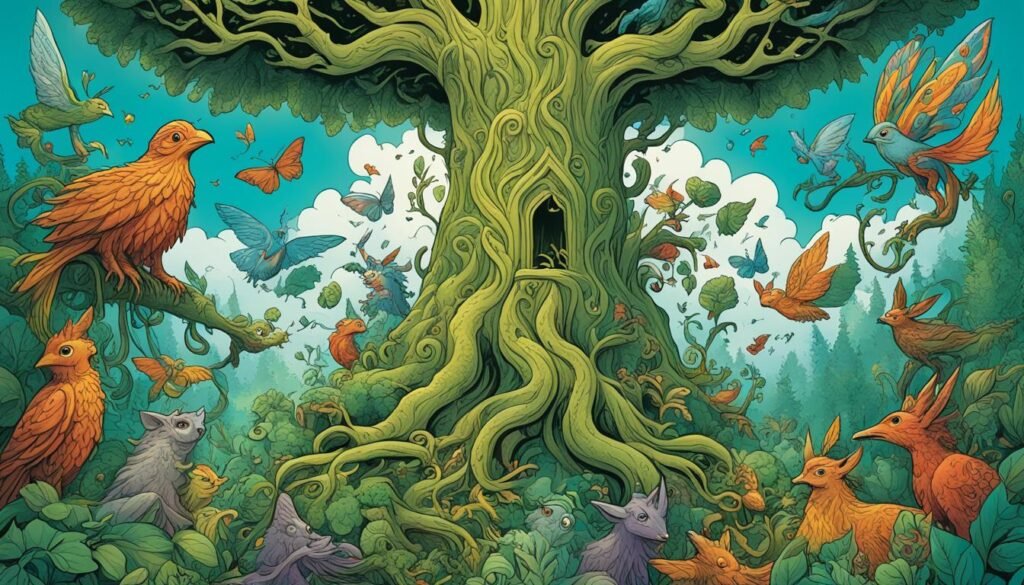
Alongside the malevolent creatures that have captured the public imagination, the Philippines’ rich mythological traditions also feature a diverse array of benevolent nature spirits and guardians that play a vital role in maintaining the balance of the natural world.4 From the revered Diwata to the diminutive Nuno sa Punso, these entities are the subjects of rituals, offerings, and deep reverence, reflecting the animistic worldview that has long been integral to the cultural identity of the Filipino people.4
Sigbin’s Place in Philippine Folklore
The Sigbin, while a distinct and captivating creature within the pantheon of Philippine mythological beings, does not exist in isolation. Rather, it is interconnected with a vast network of other supernatural entities and belief systems that have evolved and intertwined over centuries. Exploring the Sigbin’s relationships and potential connections to other mythological creatures, such as the Aswang, the Tikbalang, or the Manananggal, can shed light on the broader cultural and spiritual traditions that have shaped its place in Filipino folklore.7 These cross-connections and shared characteristics serve to illustrate the rich tapestry of Philippine mythology and the complex web of beliefs that have endured within the country.
Symbolism and Lessons Imparted
Beyond its status as a fearsome and unsettling creature, the Sigbin also holds deeper symbolic significance within Philippine mythology. Its ability to steal the hearts of its victims, for instance, may be interpreted as a cautionary tale about the perils of greed, malice, and the unchecked pursuit of power.7 Similarly, the Sigbin’s foul stench and crab-like movements may represent the corruption and moral decay that can seep into a community when left unchecked.7 In this way, the Sigbin and its associated myths serve to impart important cultural lessons and values, reminding Filipinos of the consequences of succumbing to dark impulses and the importance of maintaining a harmonious relationship with the natural and spiritual worlds.
Conclusion
The Sigbin, with its distinctive features, sinister behaviors, and deep-rooted place in Philippine mythology, stands as a testament to the richness and complexity of the country’s folkloric traditions. As one of the many diverse mythological creatures that populate the Filipino cultural landscape, the Sigbin serves as a powerful symbol of the enduring belief in the existence of supernatural forces and the unbreakable connection between the material and spiritual realms.8 The Visayas Islands and Mindanao are particularly popular for the Sigbin myth, with beliefs surrounding the creature’s ability to bring luck and wealth to its owners.8 Families that own Sigbins are known as Sigbinan, and the creatures are believed to cause illness and potential death through bites or flatulence.8
Through the study and appreciation of the Sigbin and other mythological entities, we gain valuable insights into the worldviews, beliefs, and lived experiences of the Filipino people, ultimately enriching our understanding of this vibrant and multifaceted culture.8 Speculation exists that the Sigbin legend may be based on rare animal species sightings, possibly related to the kangaroo or cat-fox species, though no confirmed sightings have been reported.8 As we delve deeper into the intriguing and often unsettling realm of Philippine mythology, we uncover a tapestry of stories that reflect the enduring power of storytelling and the enduring belief in the existence of the supernatural.
The Sigbin, with its distinctive features and sinister reputation, serves as a captivating and complex figure within this rich cultural heritage. By exploring the Sigbin and other mythological creatures, we gain a deeper understanding of the worldviews, beliefs, and lived experiences of the Filipino people, ultimately enhancing our appreciation for the diversity and vibrancy of this enchanting culture.
FAQ
What is the Sigbin, and what are its distinctive features?
What are the origins and cultural significance of the Sigbin in Philippine folklore?
How do Filipinos traditionally protect themselves from the Sigbin and other malevolent creatures?
How are the Sigbin and other Philippine mythological creatures represented in modern media and popular culture?
How do the regional variations and adaptations of the Sigbin reflect the diversity of Philippine folklore?
What is the significance of the Sigbin’s ability to steal hearts, and how does it relate to the broader symbolic meaning of the creature?
Source Links
- https://en.wikipedia.org/wiki/List_of_Philippine_mythological_creatures
- https://mythicalcreatures.info/characters/sigbin/
- https://mythicalgodsandcreatures.com/explore-filipino-mythical-creatures-a-fascinating-journey/
- https://en.wikipedia.org/wiki/Anito
- http://bicolanomythsofgodsandmonsters.blogspot.com/2018/08/aswang.html
- https://mythus.fandom.com/wiki/Sigbin
- https://www.mangkukulam.com/folklore/361/Sigbin
- https://read.cash/@susanavel2005/sigbin-mythical-creatures-in-the-philippines-96956f96

